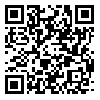Volume 5, Issue 4 (November 2018)
IJML 2018, 5(4): 255-263 |
Back to browse issues page
Department of Biology, Faculty of Basic Science, University of Sistan and Baluchestan, Zahedan, Iran.
Abstract: (1844 Views)
Background and Aims: The prevalence of latent autoimmune diabetes
in adults (LADA) among diabetic patients is less recognized and underdiagnosed. The aim of this study was to determine the prevalence of LADA in type 2 diabetic patients and to compare the characteristics of these two groups in Torbat-e Heydarieh, Iran.
Materials and Methods: Totally, 198 male and 277 female patients diagnosed with type 2 diabetes are aged between 35 -70 years were selected and the glutamic acid decarboxylase antibodies (GADA) assessment was used for the diagnosis of LADA in them. GADA in their sera was measured by commercial anti-GAD enzyme-linked immunosorbent assay (ELISA) kit. In addition, blood pressure, sera C-peptide and cholesterol levels was measured and compared in the mentioned two groups. Demographic data including age, gender, age at diagnosis, family history of diabetes, body mass index and need for insulin therapy were collected from subjects and data were analyzed using SPSS software.
Results: Of 475 patients, 53 ones (11.2%) were GADA positive. Significant difference was found between GADA positive and GADA negative patients in terms of mean age, C-peptide levels, cholesterol levels and need for insulin therapy to control the disease. As for gender, family history of diabetes, body mass index value and hypertension there was no significant correlation between these two groups.
Conclusions: The prevalence of LADA in diabetic patients was 11.2%. Presence of GAD antibodies in diabetic patients is related to reduced levels of C-peptide, increased cholesterol levels and the need for insulin during the follow-up.
in adults (LADA) among diabetic patients is less recognized and underdiagnosed. The aim of this study was to determine the prevalence of LADA in type 2 diabetic patients and to compare the characteristics of these two groups in Torbat-e Heydarieh, Iran.
Materials and Methods: Totally, 198 male and 277 female patients diagnosed with type 2 diabetes are aged between 35 -70 years were selected and the glutamic acid decarboxylase antibodies (GADA) assessment was used for the diagnosis of LADA in them. GADA in their sera was measured by commercial anti-GAD enzyme-linked immunosorbent assay (ELISA) kit. In addition, blood pressure, sera C-peptide and cholesterol levels was measured and compared in the mentioned two groups. Demographic data including age, gender, age at diagnosis, family history of diabetes, body mass index and need for insulin therapy were collected from subjects and data were analyzed using SPSS software.
Results: Of 475 patients, 53 ones (11.2%) were GADA positive. Significant difference was found between GADA positive and GADA negative patients in terms of mean age, C-peptide levels, cholesterol levels and need for insulin therapy to control the disease. As for gender, family history of diabetes, body mass index value and hypertension there was no significant correlation between these two groups.
Conclusions: The prevalence of LADA in diabetic patients was 11.2%. Presence of GAD antibodies in diabetic patients is related to reduced levels of C-peptide, increased cholesterol levels and the need for insulin during the follow-up.
| Rights and permissions | |
 |
This work is licensed under a Creative Commons Attribution-NonCommercial 4.0 International License. |




